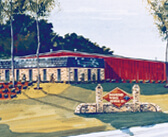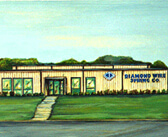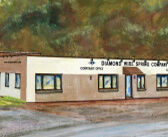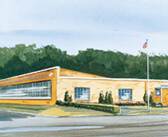
Coiling Compression Springs
COILING
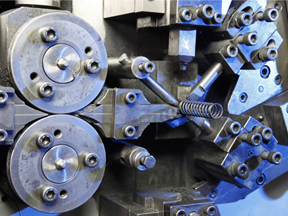
Compression Springs are by far the most common type of spring. However, Extension and Torsion are also coiled via production machinery.
When dealing with large batch quantities, both mechanical and CNC machines are used to coil the springs. The picture shows a view from the front of a mechanical coiler. The link takes you to a video of CNC machines.
The four large rollers on the front of the machine work in pairs and force the wire through the wire guide toward the coiling point as shown in the picture on the right.
There are two grooved coiling points, one vertical and one horizontal from the right-hand side of the machine which is positioned round a half-round mandrel. The four large wire feeders force the wire through the coiling points which in turn force the wire round the mandrel thus giving you the required spring coils.
The number of coils can be adjusted by the amount of wire feed. The pitch spacing and the free length of the spring are governed by the spacing tool just visible in the right-hand picture at the twenty-past position. When the spring coiling is completed, it is cut off by the cutting tool.
Before this process can begin, tooling may be required, mandrels may need ground, or created to ensure proper bend radius.
For the smaller batch sizes and particularly when using thicker wire sizes, we use semi-automatic CNC or a lathe.
A variety of springs can be coiled off a machine:
Conical springs: You may need a compression spring that's smaller at one end than the other. This is called a conical, or tapered, spring. These are basically made just like any other compression spring.
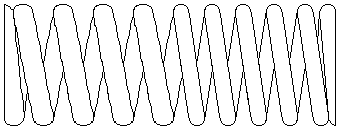
Variable-pitch springs: Sometimes you'll want a compression spring that starts out light and after a certain load is placed on it, becomes stronger. This is called a variable-pitch spring and you can see springs like this in race cars or motorcycle shock absorbers.
The key is to have some way to remember TWO coil counts: one for the first section, and one for the second. Once you can do this, you can change where you switch from one speed to another and come out with the exact spring that you want.
Snap-rings: Snap rings are easy. Just coil an extension spring with the right diameter and cut off single rings, one at a time.
Nested compression springs: Sometimes, you'll need a compression spring that's stronger than any single spring can be. In that case, you can make nested compression springs — one spring inside the other — that will be a lot stronger than a single spring. Some automobile valve spring assemblies are actually nested springs, so are the suspension springs on railroad cars. Nested compression springs are easily designed: just remember two things:
-
Nested compression springs must be different-handed. If the outer spring is right-handed, then the innerspring must be left-handed, or vice-versa.
-
The outside diameter of the inside spring CANNOT be larger than the inside diameter of the outside spring. If it is, the springs will not nest.
Very heavy wire: What's the heaviest wire that can be made into a spring? Well, coiling cold, the heaviest is about 5/8".
Springs made from the larger material start as straight bars of steel with the ends tapered down. The bars are heated red-hot and then coiled on special machinery. Some railroad suspension springs are made from 2-1/2" bars, and there have been 6" bars being made into compression springs that are used as shock absorbers for underground military command sites.
Very light wire: Common commercial coiling machines typically handle wire as fine as .008", but Diamond Wire Stocks springs made with wire as fine as .003". These microsprings are often used in medical or nanotechnology devices.
Diamond Wire Spring can manufacture one of the largest ranges of springs in the industry.


